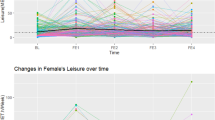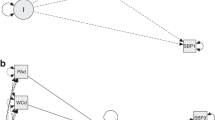Abstract
The study aims to assess the association of diet and frequency of extracurricular physical activity (PA) on blood pressure (BP) in non-obese adolescents. A total of 7185 non-obese adolescents aged 12–18 years were analysed to elucidate the relationship between BP and exercise/eating habit. Totally, 10.3% of the boys and 4.6% of the girls who responded to the questionnaire reported undertaking regular extracurricular physical exercise ⩾3 times/week and were classified as being physically active. An unhealthy eating habit (UEH) score was constructed by counting the number of ‘yes’ responses to 11 dietary behavioural items considered to be unhealthy. In logistic regression analysis, age, body mass index, exercise frequency and UEH were significantly associated with BP (P<0.001). The odds ratios (ORs) for high BP in physically more active adolescents vs those who were less active was 0.48 (95% confidence interval (CI) 0.30–0.77). The OR for high BP in those with UEH scores in the highest quartile vs those with UEH scores in the lowest quartile was 1.63 (95% CI 1.24–2.15). In conclusion, regular exercise and a healthy diet are positively associated with lower BP even in non-obese adolescents.
This is a preview of subscription content, access via your institution
Access options
Subscribe to this journal
Receive 12 digital issues and online access to articles
$119.00 per year
only $9.92 per issue
Buy this article
- Purchase on Springer Link
- Instant access to full article PDF
Prices may be subject to local taxes which are calculated during checkout

Similar content being viewed by others
References
Luma GB, Spiotta RT . Hypertension in children and adolescents. Am Fam Physician 2006; 73: 1558–1568.
Papa A, Dal CA, Capuano A, Conte G, D’Avanzo L, D’Anna F et al. Epidemiology of hypertension in children. Proc Eur Dial Transplant Assoc 1983; 20: 551–556.
Collins RT, Alpert BS . Pre-hypertension and hypertension in pediatrics: don’t let the statistics hide the pathology. J Pediatr 2009; 155: 165–169.
Sung RY, Choi KC, So HK, Nelson EA, Li AM, Kwok CW et al. Oscillometrically measured blood pressure in Hong Kong Chinese children and associations with anthropometric parameters. J Hypertens 2008; 26: 678–684.
Bouziotas C, Koutedakis Y, Nevill A, Ageli E, Tsigilis N, Nikolaou A et al. Greek adolescents, fitness, fatness, fat intake, activity, and coronary heart disease risk. Arch Dis Child 2004; 89: 41–44.
Lauer RM, Clarke WR, Lauer RM, Clarke WR . Childhood risk factors for high adult blood pressure: the Muscatine Study. Pediatrics 1989; 84: 633–641.
MacMahon S, Peto R, Cutler J, Collins R, Sorlie P, Neaton J et al. Blood pressure, stroke, and coronary heart disease. Part 1. Prolonged differences in blood pressure: prospective observational studies corrected for the regression dilution bias. Lancet 1990; 335: 765–774.
So HK, Nelson EAS, Li AM, Wong EMC, Lau JTF, Guldan GS et al. Secular changes in height, weight and body mass index in Hong Kong children. BMC Public Health 2008; 8: 320.
Bacon SL, Sherwood A, Hinderliter A, Blumenthal JA . Effects of exercise, diet and weight loss on high blood pressure. Sport Med 2004; 34: 307–316.
Erdine S, Aran SN . Current status of hypertension control around the world. Clin Exp Hypertens 2004; 26: 731–738.
Woo J, Leung SS, Ho SC, Lam TH, Janus ED . Dietary intake and practices in the Hong Kong Chinese population. J Epidemiol Community Health 1998; 52: 631–637.
Brendan O . Is this what you call junk food?, BBC NEWS 20060 November 30. URL: http://news.bbc.co.uk/2/hi/uk_news/magazine/6187234.stm.
Fasting MH, Nilsen TI, Holmen TL, Vik T . Life style related to blood pressure and body weight in adolescence: cross sectional data from the Young-HUNT study, Norway. BMC Public Health 2008; 8: 111.
Kourlaba G, Panagiotakos DB, Mihas K, Alevizos A, Marayiannis K, Mariolis A et al. Dietary patterns in relation to socio-economic and lifestyle characteristics among Greek adolescents: a multivariate analysis. Public Health Nutr 2009; 12: 1366–1372.
Wiles NJ, Northstone K, Emmett P, Lewis G . ‘Junk food’ diet and childhood behavioural problems: results from the ALSPAC cohort. Eur J Clin Nutr 2009; 63: 491–498.
Lazarou C, Panagiotakos DB, Matalas AL . Foods E-KINDEX: a dietary index associated with reduced blood pressure levels among young children: the CYKIDS study. J Am Diet Assoc 2009; 109: 1070–1075.
Lazarou C, Panagiotakos DB, Matalas AL . Lifestyle factors are determinants of children’s blood pressure levels: the CYKIDS study. J Hum Hypertens 2009; 23: 456–463.
Lydakis C, Stefanaki E, Stefanaki S, Thalassinos E, Kavousanaki M, Lydaki D . Correlation of blood pressure, obesity, and adherence to the Mediterranean diet with indices of arterial stiffness in children. Eur J Pediatr 2012; 171 (9): 1373–1382.
Wong SN, Tz Sung RY, Leung LC . Validation of three oscillometric blood pressure devices against auscultatory mercury sphygmomanometer in children. Blood Press Monit 2006; 11: 281–291.
National High Blood Pressure Education Program Working Group on High Blood Pressure in Children and Adolescents. The fourth report on the diagnosis, evaluation, and treatment of high blood pressure in children and adolescents. Pediatrics 2004; 114: 555–576.
Sallis JF, Patrick K . Physical activity guidelines for adolescents: consensus statement. Pediatr Exerc Sci 1994; 6: 302–314.
Guldan GS, Wong S, Chan J . Validation of the one-minute dietary assessment to assess the dietary behaviors of Hong Kong adolescents. Fourth Annual Conference of the International Society of Behavioral Nutrition and Physical Activity (ISBNPA) [3 - 50544] 2005.
Cole TJ, Bellizzi MC, Flegal KM, Dietz WH . Establishing a standard definition for child overweight and obesity worldwide: international survey. BMJ 2000; 320: 1240–1243.
Boreham C, Twisk J, van MW, Savage M, Strain J, Cran G . Relationships between the development of biological risk factors for coronary heart disease and lifestyle parameters during adolescence: The Northern Ireland Young Hearts Project. Public Health 1999; 113: 7–12.
Marti B, Vartiainen E . Relation between leisure time exercise and cardiovascular risk factors among 15-year-olds in eastern Finland. J Epidemiol Community Health 1989; 43: 228–233.
So HK, Sung RY, Li AM, Choi KC, Nelson EA, Yin J et al. Higher exercise frequency associated with lower blood pressure in Hong Kong adolescents: a population-based study. J Hum Hypertens 2010; 24: 646–651.
Couch SC, Daniels SR . Diet and blood pressure in children. Curr Opin Pediatr 2005; 17: 642–647.
Welsh JA, Sharma A, Cunningham SA, Vos MB . Consumption of added sugars and indicators of cardiovascular disease risk among US adolescents. Circulation 2011; 123: 249–257.
Stabouli S, Kotsis V, Toumanidis S, Papamichael C, Constantopoulos A, Zakopoulos N . White-coat and masked hypertension in children: association with target-organ damage. Pediatr Nephrol 2005; 20: 1151–1155.
Wan YP, Zhang XM, Lu LP, XU RY, Cao D, Luo KL . Distribution tendency of hypertension in 7326 primary and middle school students in Shanghai and analysis of the associated factors. J Clin Pediatr 2007; 25: 1005–1008.
Falkner B, Gidding SS, Ramirez-Garnica G, Wiltrout SA, West D, Rappaport EB . The relationship of body mass index and blood pressure in primary care pediatric patients. J Pediatr 2006; 148: 195–200.
Bao W, Threefoot SA, Srinivasan SR, Berenson GS . Essential hypertension predicted by tracking of elevated blood pressure from childhood to adulthood: the Bogalusa Heart Study. Am J Hypertens 1995; 8: 657–665.
Couch SC, Daniels SR . Diet and blood pressure elevation in children and adolescents. Arch Pediatr Adolesc Med 2004; 158: 418–419.
Acknowledgements
We thank the school principals, teachers, parents and students who participated in the study. This research project received financial support from Departmental funds and the Hong Kong Pediatric Society. Parental consent was obtained for conducting the study.
Author information
Authors and Affiliations
Corresponding author
Ethics declarations
Competing interests
The authors declare no conflict of interest.
Rights and permissions
About this article
Cite this article
So, H., Li, A., Choi, K. et al. Regular exercise and a healthy dietary pattern are associated with lower resting blood pressure in non-obese adolescents: a population-based study. J Hum Hypertens 27, 304–308 (2013). https://doi.org/10.1038/jhh.2012.41
Received:
Revised:
Accepted:
Published:
Issue Date:
DOI: https://doi.org/10.1038/jhh.2012.41
Keywords
This article is cited by
-
Tyre-pulling as concurrent training
Sport Sciences for Health (2019)
-
A Western dietary pattern is associated with higher blood pressure in Iranian adolescents
European Journal of Nutrition (2017)



